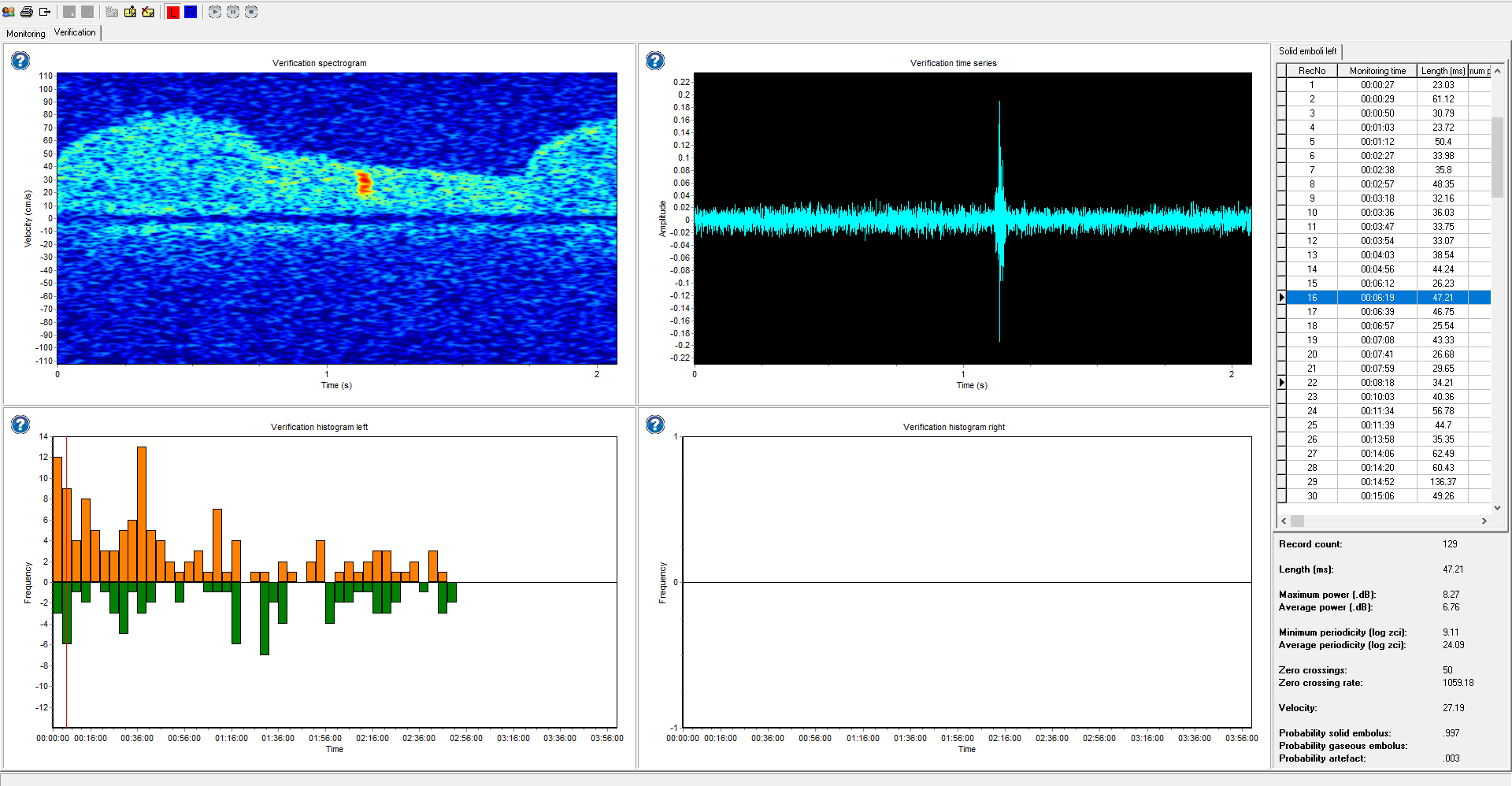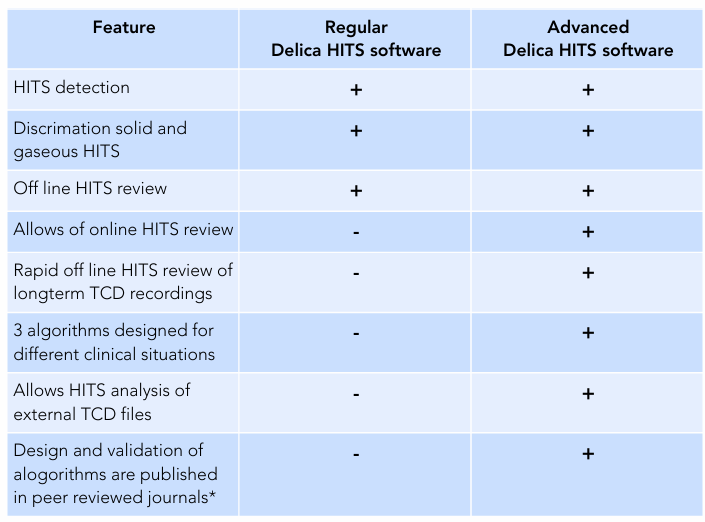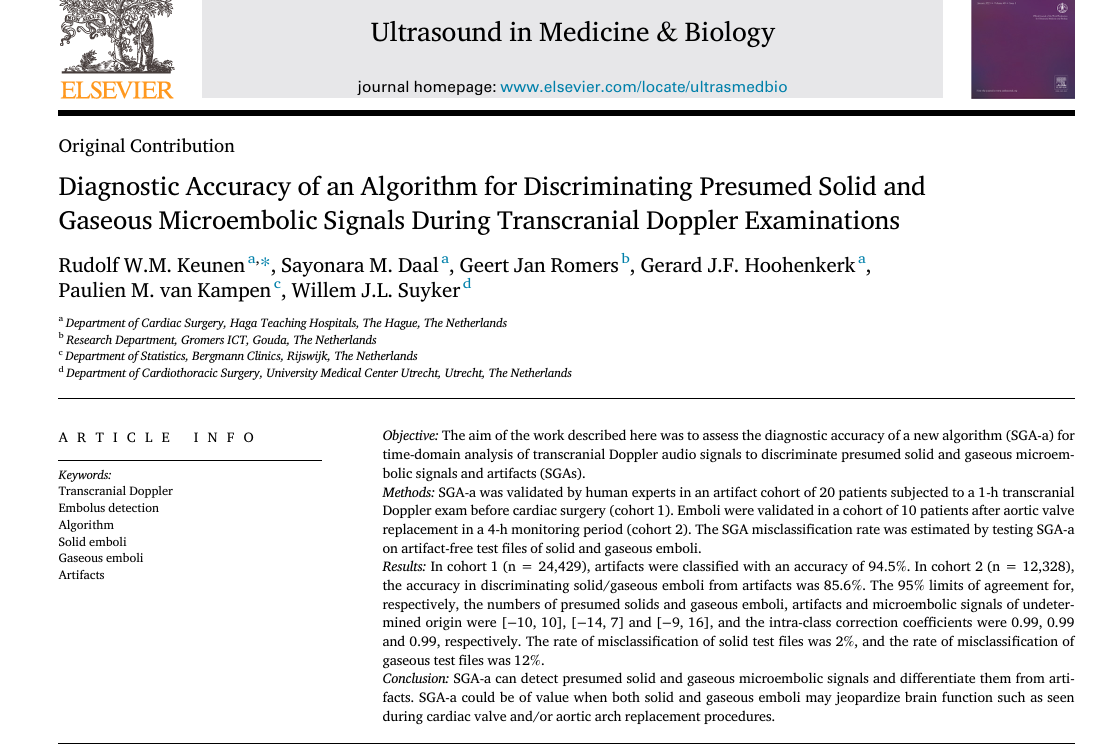Transcranial Doppler and Emboli Detection:
A micro-embolus is a tiny particle, often a blood clot, that travels through the bloodstream and becomes temporarily lodged within small vessels. When such a particle passes through the sample volume of a Transcranial Doppler (TCD) system, it produces a micro embolic signal (MES) — a short, high-intensity burst within the Doppler spectrum. Micro-emboli can originate from active embolic sources such as ulcerated carotid plaques or infected cardiac valves. These small emboli often precede larger “macro-emboli”, which may obstruct blood flow and cause Transient Ischemic Attacks (TIAs) or strokes. The presence of asymptomatic MES is considered one of the most important indicators of imminent stroke risk. Therefore, MES detection has become an essential tool in the prevention of TIAs and strokes. Transcranial Doppler ultrasound (TCD) is a highly sensitive, non-invasive, and safe method for detecting emboli in the cerebral circulation. During a typical examination, the middle cerebral arteries are monitored for approximately 30 minutes using 1.6/2 MHz transducers fixed securely with a headband. MES appear as short-lasting intensity increases in the Doppler velocity spectrum and produce characteristic “whistling,” “chirping,” or “clicking” sounds as they pass through the sample volume [1]. This unique sound pattern is caused by the regular zero-crossings of the embolic audio signal compared with the surrounding Doppler background [2].
For more details of the fundamentals of TCD embolus detection,
click the Lectures and Fundamental here to watch the video .
Click here Lecture and Fundamental to watch the video with Korean subtitle.
Clike here Lecture and Fundamental to watch the video with Spanish subtitle

Delica TCD and Emboli Detection
Accurate embolus recognition and analysis are among the key strengths of the Delica TCD systems. In addition to true MES, the TCD signal may also contain High-Intensity Transients (HITS) that arise from artifacts such as probe movements or speech. To address this, Delica offers two embolus detection software options: 1. 2. Regular Delica HITS software – the standard detection package included with all Delica TCD systems. Advanced Delica HITS software – a premium solution developed in collaboration with Dr. Keunen, a Dutch vascular neurologist and internationally recognized TCD expert. The Advanced Delica HITS software provides enhanced embolus detection accuracy and advanced analysis tools designed for clinical research and high-level diagnostic applications. The table below summarizes the main differences between the Regular and Advanced HITS software options. Depending on your clinical focus or research requirements, you can choose the standard configuration or upgrade to the Advanced Delica HITS detection system.
For more information, watch the Advanced HITS video by clicking the link here Delica advanced HITS detection to learn more.


* see References 2,3,4 References:
[1] Ringelstein EB, et al. Consensus on microembolus detection by TCD. International Consensus Group on Microembolus Detection. Stroke. 1998 Mar;29(3):725-9. doi: 10.1161/01.str.29.3.725. PMID: 9506619.
[2] Keunen RW, et al. Introduction of an embolus detection system based on analysis of the transcranial Doppler audio-signal. J Med Eng Technol. 2008 Jul-Aug;32(4):296-304. doi: 10.1080/03091900701541265. PMID: 18666009.
[3] Keunen RW, et al. Diagnostic Accuracy of an Algorithm for Discriminating Presumed Solid and Gaseous Microembolic Signals During Transcranial Doppler Examinations. Ultrasound Med Biol. 2023 Dec;49(12):2483-2488. doi: 10.1016/j.ultrasmedbio.2023.08.011. Epub 2023 Sep
[4] Keunen RW, et al. Validation of an algorithm that separates gaseous micro-embolic signals and artifacts during transcranial Doppler persistent foramen ovale examinations, WFUMB Ultrasound Open, Volume 2, Issue 2,2024,100067,ISSN 2949-6683, https://doi.org/ 10.1016/j.wfumbo.2024.100067 (https://www.sciencedirect.com/science/article/pii/ S2949668324000351).
